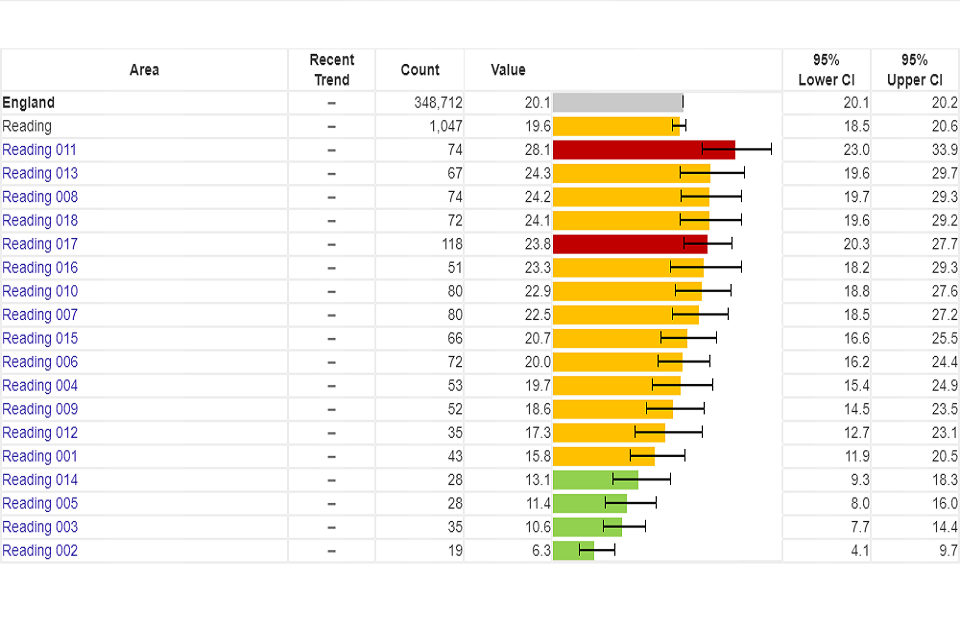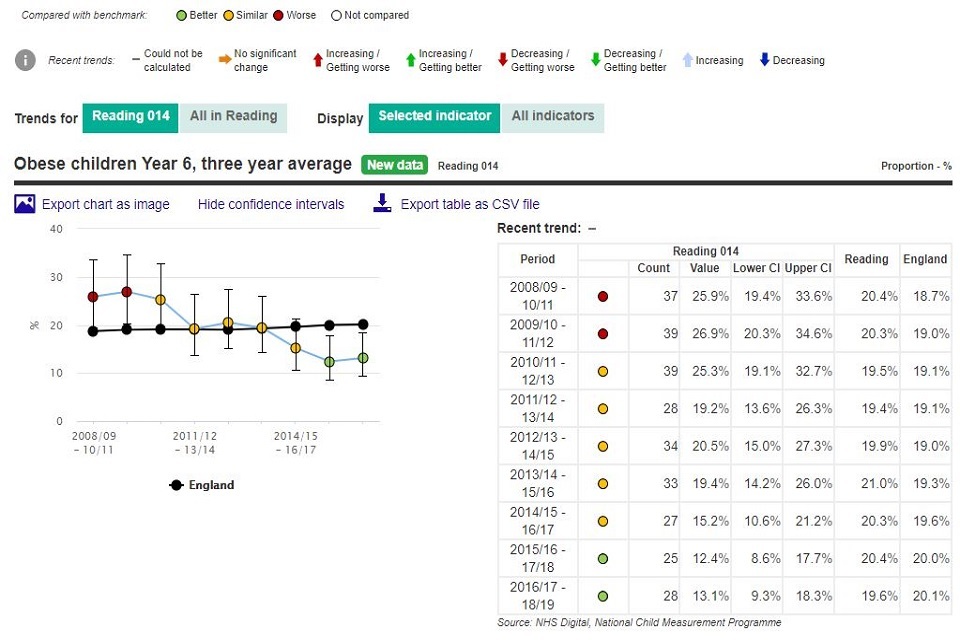NCMP and Child Obesity Profile: short statistical commentary March 2020
Published 3 March 2020
1. New in this update
New National Child Measurement Programme (NCMP) data for the academic year 2018 to 2019 has been added to the NCMP and Child Obesity Profile. The following indicators have been updated showing data for middle super output areas (MSOAs), Electoral Wards and Clinical Commissioning Groups (CCGs), together with local authority and England figures for comparison.
- Obese children Reception year (aged 4 to 5 years)
- Children with excess weight Reception year (aged 4 to 5 years)
- Obese children Year 6 (aged 10 to 11 years)
- Children with excess weight Year 6 (aged 10 to 11 years)
Data is presented by area of child residence using rolling 3-year combined NCMP data to show small area trends from 2008 to 2009 up to 2018 to 2019. The small area level data will assist planning and delivery of services for children and the targeting of resources at a local level to help reduce the prevalence of excess weight and obesity.
2. Main findings
- there is variation in child obesity and excess weight prevalence at small area level throughout England
- obesity prevalence is highest among children living in the most deprived areas of England
3. Summary
This data publication provides trend data on the prevalence of excess weight (overweight including obesity) (from NCMP 2010 to 2011 up to 2018 to 2019) and obesity (from NCMP 2008 to 2009 up to 2018 to 2019). The data presented is based on area of child residence, for 2011 MSOAs, 2018 Electoral Wards, 2018 CCGs, 2013 local authorities and England. The data for 2019 Electoral Ward will be available in September 2020 to synchronise with the update to the PHE Local Health tool .
To produce as robust an indicator as possible at small area level, the prevalence estimates use three years of NCMP data combined; the latest data is presented for 2016 to 2017 up to 2018 to 2019 combined. The comparator data provided at local authority and England level also uses three years of NCMP data combined.
4. Interpreting the data
Prevalence of child obesity and excess weight varies across England. Analysis of national[footnote 1] and local authority[footnote 2] data shows that children resident in the most deprived areas in England are at the highest risk of being overweight and obese.
In England 9.6% of children in Reception were obese in the period 2016 to 2017 up to 2018 to 2019, varying from 4.8% to 13.8% at lower tier local authority level. Among children in Year 6 in England 20.1% were obese in the period 2016 to 2017 up to 2018 to 2019, varying from 10.0% to 29.5% between lower tier local authorities. There is often considerable variation between neighbourhoods within each local authority.
This variation within local authorities can be examined using data for MSOAs and wards. The data published in the NCMP and Child Obesity Profile will help to identify pockets of high obesity and excess weight and enable changes in prevalence to be monitored over time. This may help to assist planning and delivery of services for children.
Figures 1 and 2 show examples of how the data can be examined to identify local patterns and trends in child obesity prevalence using the data at MSOA level.
When interpreting this small area level data it is important to consider the 95% confidence intervals for the values as they show the level of uncertainty in the prevalence estimates and provide a range of values in which we can be 95% confident contain the true value.
In general, the greater the number of measurements used within any analysis, the more reliable the resulting statistics (for example the England and local authority figures). Analysis based on small areas (such as MSOA and Ward level) may be affected by small number variation, and therefore the prevalence figure may not provide a reliable estimate of the true value in the population.
Figure 1 shows the prevalence of obesity among Year 6 children in Reading local authority by MSOA of residence. Obesity prevalence varies between 6% up to 28% across all MSOAs in Reading. In Figure 1, MSOA ‘Reading 011’ has the highest prevalence value in the local authority of 28.1% but the 95% confidence intervals range from 23.0% to 33.9%. We can be confident that Year 6 obesity prevalence in MSOA Reading 011 is higher than the England and Reading LA values as their confidence intervals do not overlap with that for ‘Reading 011’.
When making comparisons with other MSOAs however, we can only say with some certainty that prevalence in ‘Reading 011’ is higher than the prevalence in MSOAs 001, 002, 003, 005, and 014 as in only these cases the confidence intervals do not overlap. For the other MSOAs the confidence intervals do overlap so we cannot be confident that the prevalence in MSOA Reading 011 is higher than the prevalence in any of these MSOAs. The bars on Figure 1 are shaded red (higher), amber (similar) and green (lower) to help compare the MSOA value to the England value.
Figure 1: Prevalence of obesity among Year 6 children (aged 10 to 11 years) in Reading local authority by Middle Super Output Area of residence, NCMP 2016 to 2017 up to 2018 to 2019 with 95% confidence intervals

Figure 1:Prevalence of obesity among Year 6 children (aged 10 to 11 years) in Reading local authority by Middle Super Output Area of residence, NCMP 2016 to 2017 up to 2018 to 2019 with 95% confidence intervals
Figure 2 shows the trend in obesity prevalence among Year 6 children for an example MSOA, compared with the local authority and England values. Obesity prevalence in this MSOA has decreased between 2008 to 2009 and 2018 to 2019.
Figure 2: A screenshot from the Fingertips profile showing the trend in prevalence of obesity among Year 6 children (aged 10 to 11 years) for one MSOA in Reading local authority, NCMP 2008 to 2009 up to 2018 to 2019 with 95% upper and lower confidence intervals (UCI and LCI) around MSOA data

Figure 2: A screenshot from the Fingertips profile showing the trend in prevalence of obesity among Year 6 children
5. Background
Further information about this publication and the data used:
- the NCMP annually measures the height and weight of over 1 million children in England and provides robust data on rates of child obesity and excess weight
- detailed metadata is available in the NCMP and Child Obesity profile
- data for 2018 Electoral Wards and 2018 CCGs of child residence is estimated from suppressed 2011 MSOA data - this is to avoid the potential disclosure of small numbers which could result if data for non-coterminous geographies was released
- in the 2006 to 2007 NCMP, 57.7% of records had a valid child postcode of residence; in 2007 to 2008 this figure had risen to 95.1%; in the NCMP since 2008 to 2009, over 99% of child records have a valid postcode, providing a large enough coverage to produce reliable estimates at small area level
- the NCMP data for Year 6 children from 2006 to 2007, 2007 to 2008, and 2008 to 2009 needs to be should be treated with caution as low participation levels in these years led to underestimation of obesity prevalence
- children with a body mass index (BMI) greater than or equal to the 95th centile of the British 1990 growth reference (UK90) BMI distribution have been classified as obese
- children with a BMI greater than or equal to the 85th centile of the British 1990 growth reference (UK90) BMI distribution have been classified as overweight including obese (excess weight)
- these indicators can also be examined in the Public Health England (PHE) Local Health tool - the latest data may not be available in Local Health due to different publication dates
- the statistics were produced using the national analysis dataset provided to Public Health England by NHS Digital
Responsible statistician, product lead: Caroline Hancock
For queries relating to this document, please contact: ncmp@phe.gov.uk
PHE Publications gateway number: 2018035
